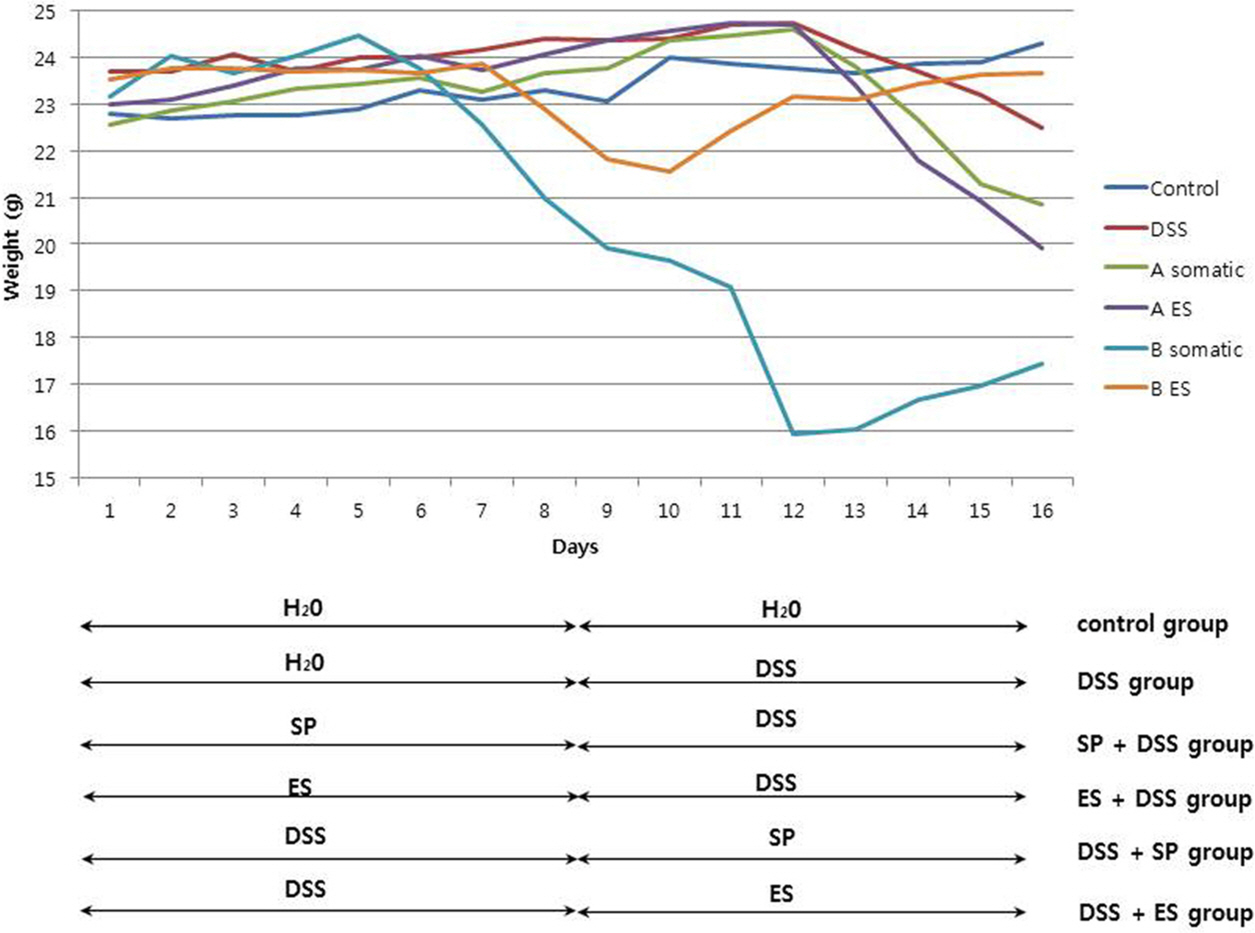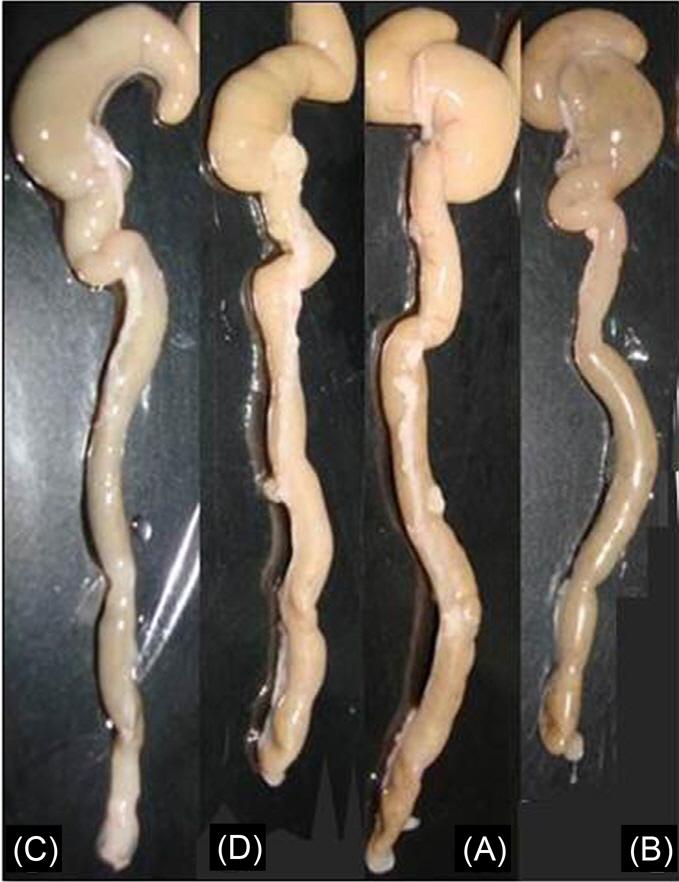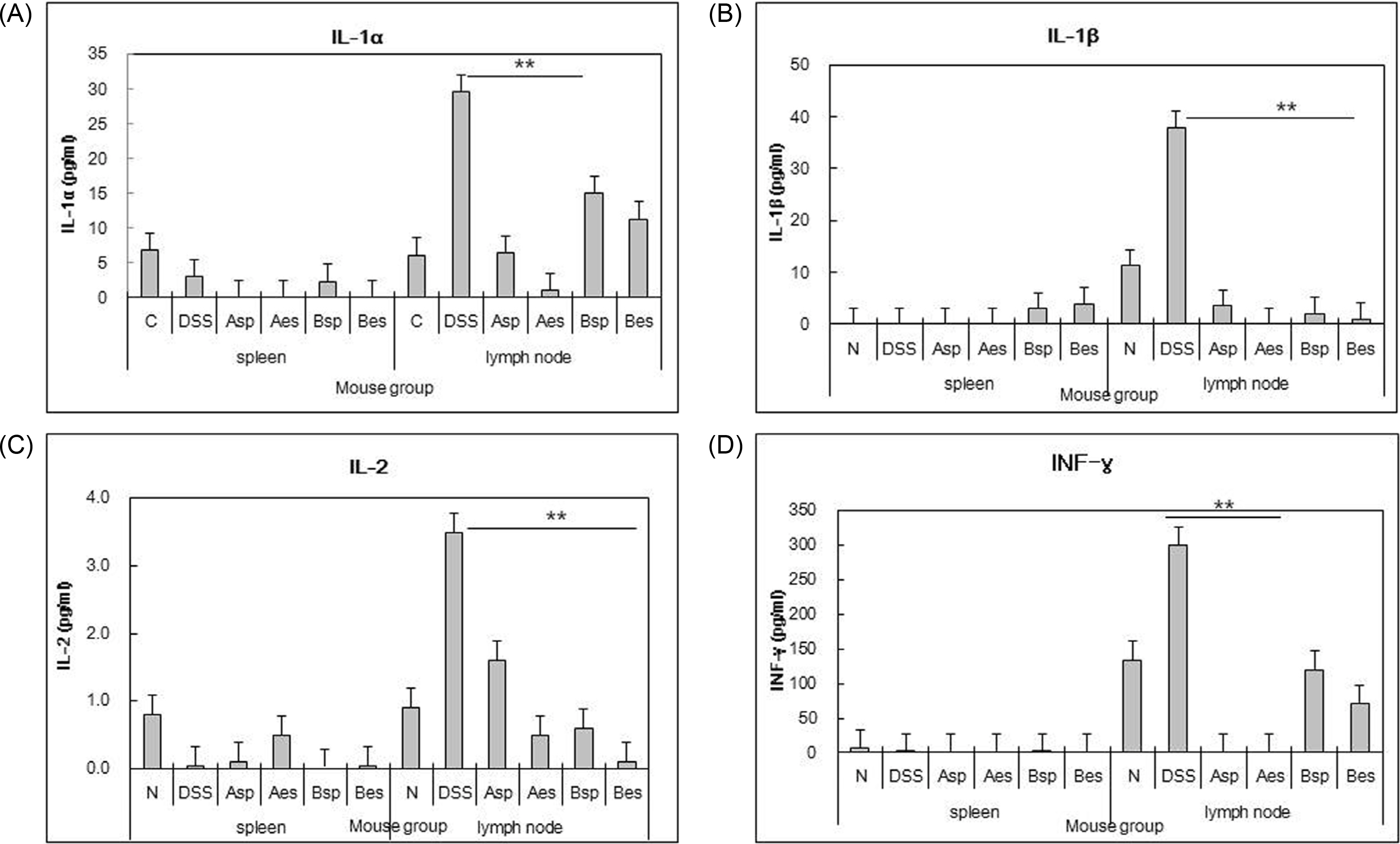Kosin Med J.
2013 Dec;28(2):107-113. 10.7180/kmj.2013.28.2.107.
Preventive and Therapeutic Effects of Anisakis simplex Larval Protein in a Mouse Model of Crohn'S Disease
- Affiliations
-
- 1Department of Parasitology and Genetics, College of Medicine, Kosin University, Busan, Korea. sunnyock@kosin.ac.kr
- KMID: 1993568
- DOI: http://doi.org/10.7180/kmj.2013.28.2.107
Abstract
OBJECTIVES
Some helminths have been known to have a treatment effect in inflammatory bowel diseases, including Crohn's disease (CD); however, live parasite therapy can cause unwanted side effects. To develop a safe therapeutic, we investigated the preventive or therapeutic potential of proteins from the third stage larva of A. simplex in a mouse model. We also analyzed the cytokine profile from splenic and mesenteric lymph node lymphocytes to elucidate the underlying immunological mechanism.
METHODS
CD was induced in mice with DSS, and the effect of an A. simplex larval protein on CD was assessed. A change in body weight and DAI (disease activity index) were observed in mice. The expression levels of cytokines from mesenteric lymph nodes (MLN) compared to splenic lymphocytes were measured with ELISA.
RESULTS
Peritoneal administration of preventive and therapeutic A. simplex larval proteins attenuated DSS-induced CD by a reduction of the DAI and weight loss. A shortening of colon length was more definitely observed in the therapeutic group than in the preventive group. The cytokine expression levels were more obvious in lymphocytes from mesenteric lymph nodes than from splenic lymphocytes.
CONCLUSIONS
Taken together, these results suggest that A. simplex proteins can change cytokine profiles and may have a preventive effect in DSS-induced CD mice.
Keyword
MeSH Terms
Figure
Reference
-
1.Strachan DP. Hay fever, hygiene, and household size. BMJ. 1989. 299:1259–60.
Article2.Yazdanbakhsh M., Kremsner PG., van Ree R. Allergy, parasites, and the hygiene hypothesis. Science. 2002. 296:490–4.
Article3.Weinstock JV., Elliott DE. Helminths and the IBD hygiene hypothesis. Inflamm Bowel Dis. 2009. 15:128–33.
Article4.Summers RW., Elliott DE., Urban JF Jr., Thompson RA., Weinstock JV. Trichuris suis therapy for active ulcerative colitis: a randomized controlled trial. Gastroenterology. 2005. 128:825–32.
Article5.Mortimer K., Brown A., Feary J., Jagger C., Lewis S., Antoniak M, et al. Dose-ranging study for trials of therapeutic infection with Necator americanus in humans. Am J Trop Med Hyg. 2006. 75:914–20.
Article6.Van Kruiningen HJ., West AB. Potential danger in the medical use of Trichuris suis for the treatment of inflammatory bowel disease. Inflamm Bowel Dis. 2005. 11:515.
Article7.Hsu S-J., Tseng P-H., Chen P-J. Trichuris suis therapy for ulcerative colitis: nonresponsive patients may need anti-helminth therapy. Gastroenterology. 2005. 129:768–9.
Article8.Cho MK., Ahn SC., Kim DH., Yu HS. Parasite excretory-secretory proteins elicit TRIF dependent CXCL1 and IL-6 mediated allergic inflammation. Parasite Immunol. 2010. 32:354–60.
Article9.Park SK., Cho MK., Park HK., Lee KH., Lee SJ., Choi SH, et al. Macrophage migration inhibitory factor homologs of Anisakis simplex suppress Th2 response in allergic airway inflammation model via CD4+CD25+Foxp3+ T cell recruitment. J Immunol. 2009. 182:6907–14.10.Kim J., Jo JO., Choi SH., Cho MK., Yu HS., Cha HJ, et al. Seroprevalence of antibodies against Anisakis simplex larvae among health-examined residents in three hospitals of southern parts of Korea. Korean J Parasitol. 2011. 49:139–44.11.Breese E., Braegger CP., Corrigan CJ., Walker-Smith JA., MacDonald TT. Interleukin-2- and interferon-gamma-secreting T cells in normal and diseased human intestinal mucosa. Immunology. 1993. 78:127–31.12.Fuss IJ., Neurath M., Boirivant M., Klein JS., de la Motte C., Strong SA, et al. Disparate CD4+ lamina propria (LP) lymphokine secretion profiles in inflammatory bowel disease. Crohn's disease LP cells manifest increased secretion of IFN-gamma, whereas ulcerative colitis LP cells manifest increased secretion of IL-5. J Immunol. 1996. 157:1261–70.13.Hommes DW., Mikhajlova TL., Stoinov S., Stimac D., Vucelic B., Lonovics J, et al. Fontolizumab, a humanised anti-interferon gamma antibody, demonstrates safety and clinical activity in patients with moderate to severe Crohn's disease. Gut. 2006. 55:1131–7.14.Reinisch W., Hommes DW., Van Assche G., Colombel JF., Gendre JP., Oldenburg B, et al. A dose escalating, placebo controlled, double blind, single dose and multidose, safety and tolerability study of fontolizumab, a humanised anti-interferon gamma antibody, in patients with moderate to severe Crohn's disease. Gut. 2006. 55:1138–44.15.Ruyssers NE., De Winter BY., De Man JG., Loukas A., Pearson MS., Weinstock JV, et al. Therapeutic potential of helminth soluble proteins in TNBS-induced colitis in mice. Inflamm Bowel Dis. 2009. 15:491–500.
Article16.Summers RW., Elliott DE., Urban JF Jr., Thompson R., Weinstock JV. Trichuris suis therapy in Crohn's disease. Gut. 2005. 54:87–90.
Article17.Khan WI., Blennerhasset PA., Varghese AK., Chowdhury SK., Omsted P., Deng Y, et al. Intestinal nematode infection ameliorates experimental colitis in mice. Infect Immun. 2002. 70:5931–7.
Article
- Full Text Links
- Actions
-
Cited
- CITED
-
- Close
- Share
- Similar articles
-
- Seroprevalence of Antibodies against Anisakis simplex Larvae among Health-Examined Residents in Three Hospitals of Southern Parts of Korea
- Larval Anisakid Infections in Marine Fish from Three Sea Areas of the Republic of Korea
- Expression and Characterization of alpha-Methylacyl CoA Racemase from Anisakis simplex Larvae
- Phylogenetic and phylogeographic analyses of Anisakis simplex sensu stricto (Nematoda: Anisakidae) from the common minke whale in Korean waters
- Immune reactions and allergy in experimental anisakiasis





